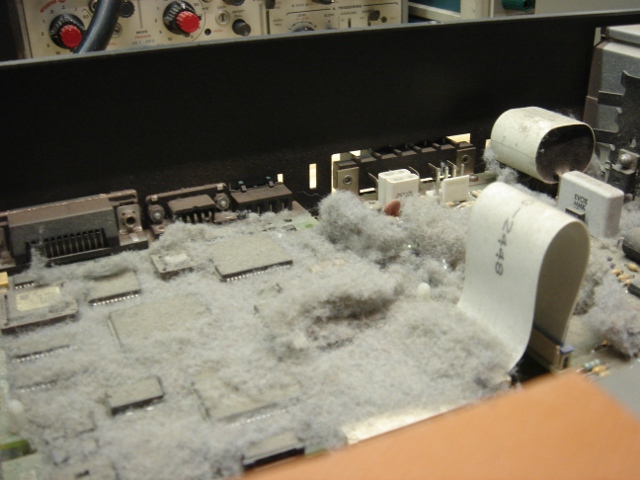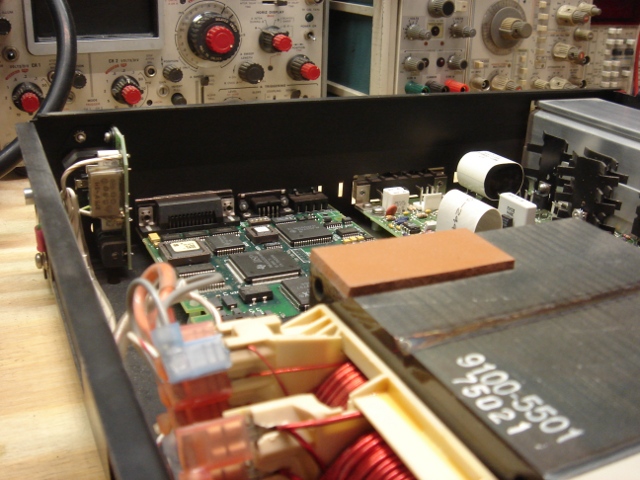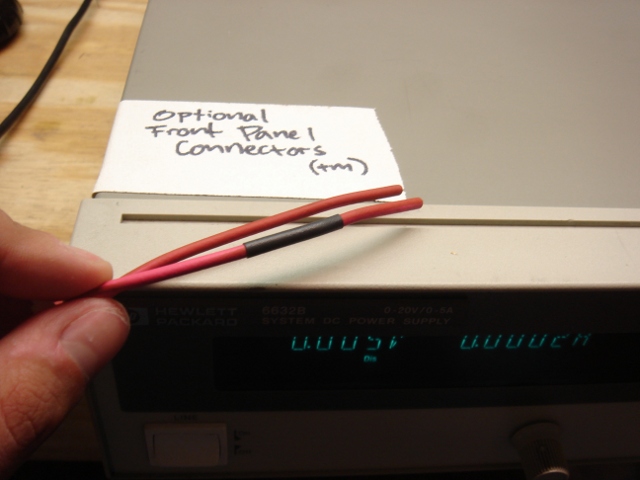Care and Feeding of the HP 6632b
Yesterday Narrat1ve got a new (sort of) bench power supply in the form of an eBayed HP 6632b!
You can read what HP says about it but it basically kicks as much ass as I could really want or expect a single output PSU to kick. Until now I’d been using a couple of Tektronix PS503a units (which are pretty great, actually) and a Power Designs TW6050a (which is very heavy). However in the course of figuring out some VCO stuff I found myself really wanting to be able to step by small numbers of millivolts and trust with some certainty that what I was asking for was what I was getting (and the 6632b’s microamp measurement is handy for embedded stuff, too).
Anyhoo, the unit showed up all kinds of Dirt McGirt:

And had all kinds of goofy user settings in it. Ebay buyers of HP supplies take note:
Because I’m the kind of guy who reads the manual (and because a buddy of mine had just gotten one of these) I knew that it should have powered up in a certain state (namely, with the output disabled!) and it didn’t. One of the cool things about these supplies is that they talk RS-232 in many languages. One of the annoying things is that this one happened to be set to a language which sucked (COMPatibility, I guess an older GPIB compliant standard) and didn’t allow you to do many of the things that you can do with SCPI even from the front panel. After some head scratching and a LANG change this was resolved. The next problem was the fact that the front panel meter was a little off from what I was measuring at the output. “Lucky for me I have a fancy bench meter, and it’s easy to calibrate this thing,” I thought. WRONG.
Somebody had set the calibration password on this in times long gone by and there ain’t no changing it. I got the service manual and it turns out you can defeat password protection by flipping a DIP switch inside the chassis. This is when I took it apart and discovered the dirtball above.
After much swearing, compressed air, and windex, the inside of the chassis looked like this:

In addition to letting me get at the DIP switches, this also gave me a spiritual sense of wellness at having un-funked a nice piece of gear that somebody had really let go. It also made me less worried that there were secret vermin in my apartment that were taking refuge in my bench. It also made the fan run quieter.
In the course of doing this I also realized that the goobers who used this thing before had removed the terminal block jumpers from between the SENSE and OUTPUT screws. I replaced them. Who are these people? Were they so fancy they were using 4-wire? Who does that? Somehow I’m suspect.
Finally, I did the calibration. When it was done, the front panel meters were dead on, and the output voltage was within 0.2mV (worst case) of what my fancy meter says it should have been. Not perfect, but not bad for an eBay bench supply!
Finally, I installed my own “Front Panel Connectors” so I could use the thing without monkeying with the back:

Baller status!
xo
TB
Tags: Electronics Advice, Test Equipment
August 16th, 2011 at 3:10 pm
Nice!
How much was the shipping on the Ebay? This thing is heavy!!
p.s. I have two such supplies and they are really cool.
If you read through the manual, you know, that it can also behave as current sink (load).
Read the application-note about testing the solar-cells. I’m testing batteries with it :)
August 16th, 2011 at 3:19 pm
Thanks!
I can’t remember the shipping, but yeah, it definitely keeps my workbench from blowing away in the wind. I’ve been nothing but happy with it so far, and I remember from the manual that it does a lot more than I use it for.
One nice thing is that the current meter on it is fairly precise. Not only is it beefy, but the resolution is such that you can sometimes find bias supply / sleep / low-current problems in circuits without strapping a real ammeter in circuit in places. Or at least you can get close.
March 21st, 2012 at 5:29 pm
[…] already tested it with great results. Narrat1ve also bought one of these and wrote about it in his blog. Mine didn’t need the cleaning but I don’t have the equipment to calibrate it – […]
April 13th, 2012 at 12:00 pm
Hi
I just bought 2 of these , and was wondering if you would like to briefly explain:
How you did the voltage calibration ?
I have looked in the service & user manual , and ie. i dont have the mentioned dummyload for the Amp calibration (HP PN 0811-2878).
I also just got an Agilent 34401A , i hope that’ll qualify as a “Fancy Meter”.
TIA
Bingo
April 26th, 2012 at 10:25 am
Oh, IIRC I’m pretty sure I just set the zero range and the low current ranges using resistors I had around the workbench. I also used a 34401a, although the manual calls for an 8.5 digit meter. Still, if your device is significantly out of cal, you can get a lot closer.
TB
November 21st, 2012 at 8:45 pm
How is the acoustic noise from the unit?
February 11th, 2013 at 9:41 am
It’s not bad. I have some old scopes with fans in them, and the 6632b is typically quieter than most of them. Furthermore, the fan speed kicks up when the current draw increases, so it’s a nice audible indication that something has gone amiss in your DUT :-)
November 18th, 2016 at 6:05 pm
Even though this thread is quite old, my “new” 6632B is quite old too. I just got it from a good friend of mine, who owned two of these fine instruments.
I’m really happy with it after the first trials. I used a similar Philips Power supply source before (PE 1539), but this thing is stuffed with only imprecise analog meters and is not comparable with this fine HP voltage supply, and one does have to use an additional precise voltage meter (I do use a Fluke 8842A Multimeter, a quite old, but freshly calibrated, still precise voltmeter ;)).
I do enjoy the use of these fine old instruments (it’s astonishing, they do feature no internet Connection, no voice control, no “App”, but even without all that stuff, they do work as expected :)).
Regards
Uli
November 28th, 2016 at 6:27 pm
Although my original post about this is pretty old I still use this same unit as my main bench supply. It still seems to be in cal from 5 years ago. Hope yours treats you well!